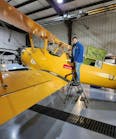Most U.S. Helicopter Accident Indicators Pointed in Right Direction During 2020
WASHINGTON DC – The helicopter industry recorded another year of decreasing accidents, with the number of fatal accidents dropping by more than 20 percent, and a 2.6 percent reduction in the total accident rate (per 100,000 flight hours).
Nick Mayhew, industry co-chair of the U.S. Helicopter Safety Team, urges the industry to stay vigilant and work hard to improve the numbers. “Our numbers are improving, but we’re not where we want to be yet. We know our aircraft are sound and safe, thanks to efforts by manufacturers. The vast majority of accidents result from human error. Therefore, pilots and operators must continue to strengthen our safety programs holistically, improving training programs, safety culture and effective use of technology.”
Preliminary data shows 94 total U.S. helicopter accidents in 2020 compared to 121 accidents the year before. There also were 19 fatal accidents in 2020 compared to 24 fatal accidents in 2019. Comparing 2020 to 2013 (when the USHST was officially formed), fatal accidents are down by more than 35 percent. The fatal accident rate, however, for the prior five-year span continued to creep upward.
A bright spot during 2020 occurred late in the year when the U.S. helicopter community went a record 107 days without a fatal accident. (August 25 through December 9)
Total U.S. Accidents
2020 94 accidents, 19 fatal accidents, 35 fatalities 22% decrease in accidents
2019 121 accidents, 24 fatal accidents, 51 fatalities compared to 2019
2018 122 accidents, 24 fatal accidents, 55 fatalities
2013: 146 accidents, 30 fatal accidents, 62 fatalities 36% decrease in accidents
compared to 2013
“Having these statistics continue to move in a good direction is a positive and I applaud my colleagues for all they do each day to make our industry safer,” adds Mayhew. “But we can do better. Zero fatalities remain our goal. Here at USHST, we continue to work on safety enhancements based on the accidents we have analyzed and we’re regularly developing safety materials to support this effort.”
Comparing five-year accident rates (number of accidents per 100,000 flight hours), the total accident rate is decreasing, but the fatal accident rate is slowly rising.
2016-20 2015-19 2014-18
Total Accident Rate 3.71 3.81 3.85 down 2.6% since prior year
Fatal Accident Rate 0.68 0.65 0.62 up 4.6% since prior year
Here are the most significant safety materials developed by the USHST. To reduce the number of fatal accidents, the U.S. Helicopter Safety Team (www.USHST.org) has been working on advancing safety enhancements based on analysis of dozens of fatal accidents.
- White paper showing how UAS (drones) can supplement and support manned helicopters in high-risk operations and environments.
- New airmanship bulletins on the Vortex Ring State and on Power Available Limitations.
- Recommended practices document and a fact sheet offering guidelines for preflight inspections and final walk-arounds.
- In collaboration with the FAA and the GAJSC, promotion of a new reference tool for pilots about how impairment can be caused by certain over-the-counter medications.
- An extensive Recommended Practices Guide regarding the use of simulation to rehearse at-risk scenarios and develop safe decision-making.
- Recommended Practices Guide and briefing card on the use of Crew Resource Management for civil helicopter crews.
- “Go Local” interactive safety workshops modified from a face-to-face setting to an interactive webinar version. Developed in conjunction with the FAASTeam and focused on reinforcing a culture of safety among pilots within the helicopter community.
“With these current initiatives and future efforts,” says Mayhew, “we are striving to reinforce a culture of safety among helicopter pilots and helping them live and fly another day,”
More information about the USHST, the International Helicopter Safety Foundation, its reports, safety tools, Reel Safety audio-visual presentations, and YouTube safety videos can be obtained at www.USHST.org, at www.IHSF.aero and on the USHST and IHSF Facebook pages.
